English Chalk Figures
Thursday, 16th August 2007 by James Turnbull
Along with the more modern pastime of making crop circles, etching chalk figures into the side of hills seems to be a peculiarly English obsession.
The Uffington White Horse is the confirmed oldest of the many chalk figures in England, dating all the way back to the Bronze Age.1 There are many different theories as to why the 110 metre-long horse looks so odd, with some people even claiming it's actually supposed to be a dragon2.
You can freely walk about on white horse hill (as I did last week), but the shape makes very little sense when viewed close up - I imagine it was very difficult for the Bronze age artists to know exactly how it would turn out.
The Long Man of Wilmington is etched into Windover Hill, Sussex, and probably dates from the 16th or 17th century AD. He's around 69 metres tall, which would have made him an excellent navigational aid for Nazi pilots during WWII, if he hadn't been painted green to prevent them doing exactly that.
These days he's been restored to his original colour but - as with all chalk figures - the Long Man of Wilmington has eroded over the centuries, and it's quite possible that he actually looks very different today than he would have done originally. Some historians believe he might have once held a scythe and rake, or perhaps even been as fortunately endowed as that other famous chalk-man, the Cerne Abbas Giant.
Of course there's always a chance that he was originally baking a couple of primitive doughnuts!
There are many more real chalk figures to be seen on English hills, which you can explore with Felippo's White Horse Collection, the Hill figure page, or Wikipedia's pages on Hill figures, the Long Man of Wilmington and the Uffington White Horse.
Thanks to Anthony Houghton, Dee & others.
-
The replica in Mexico isn't nearly as old. ↩︎
-
These people believe that the nearby Dragon Hill (Wikipedia page) is where St George slew the dragon, spilling its blood on the hilltop and "leaving forever a bare white patch where no grass can grow". ↩︎
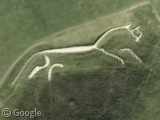
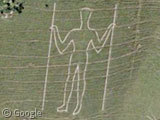
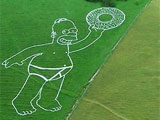
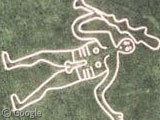

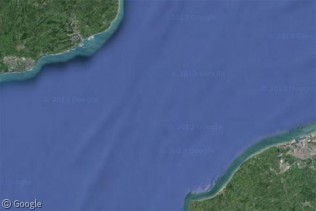
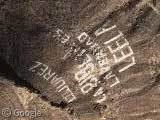
The Cerne Abbas Giant seems to have taken up Karaoke
Any idea what is up with those tiny squares and circles in the fields where they have planted around them, leaving little islands in the midst of the crops?
Don’t know what the square ones are, but the circles are almost certainly round barrows. The area around Uffington is littered with neolithic and bronze age sites such as the long barrow Waylands Smithy (View Placemark (51.566667,-1.596136))
Oops. How did that space creep in there? View Placemark (51.566667,-1.596136)
Not sure what happened to your link ajho, but here’s a maps link for Waylands Smithy: Waylands Smithy (compare to a plan of the site for reference)
I myself have just learned a lot from the Wiki page about Long Barrows, but the gist of them is that they were burial chambers for the dead, which were constructed anything up to 6 thousand years ago!
I love searching for the White Horses with Google Earth, I’ve found most of the ones that are visible. And I have finally seen on from the ground while traveling back to London from Stonehenge a few weeks ago, really fantastic. I did learn some interesting things about some of what you might see. Lots of the circles may be old stone circles, or barrows, or they might also be the remnants of W.W.II storage tanks, during the war I was told, it was not unusual for storage tanks to be buried so that they weren’t targets for bombers. Most of the tanks left scars on the landscape and can still be seen. There are also a lot of left over gun emplacements from W.W.II as well and they also left some strange foot prints on the landscape. Then there are ancient hill forts.
Then there is the Uffington Horse, which we can finally see. As mentioned here before. But there is another very closeby structure that has an interesting story. It’s right next to the horse on top of a hill, you can see it because of the little white patch on top. It’s called Dragon Hill, or sometimes Dragon’s Knob, and it’s where legend has it that St. George slew the dragon. According to the legend, the dragon bled out on top of Dragon Hill and the place where the blood fell is the white patch on top, and it’s true, nothing has ever been able to grow in that patch, it’s always been bare. You decide 🙂